Quality of the Environment in Japan 1995
PartI
Chapter1. The Growth of Civilization and Global Environmental Issues
Originally, humans were just one form of life among many life forms, and composed a part of a biosystem with those others and with the surrounding environment. But humans also have come to possess a distinctive existence in the biosphere or their environment, consuming vastly more natural resources and energy than other living things, building up civilizations while working great changes to their environ-ment, and registering remarkable increases in their individual numbers (population). A glance at the history of civilization shows that human civilizations influence the environment. As a result, environments have undergone change to the degree that civilizations have been unable to cope with, some civilizations of the past actually having been destroyed. Humans today also have many areas that they need to reflect on and learn from if they are to understand the ways of civilization that can let them continue to do sustainable development.
In this chapter, the above-mentioned points are examined. Mov-ing through the transitions in ways of thinking until the adoption of the Basic Environment Plan, also awareness in modern civilization for sustainable development is examined. Then, consideration is made on what directions should be taken to be able to pass on a bounteous, prosperous environment to far future generations, to be able to search out problems of modern civilization so as to build societies where sustainable development is possible, and to be able to build a sustainable new civilization.
Section1. The Position of Human Beings in the Global Biosphere
In 1925, the fossilized bones of an early man were discovered in Johannesburg, South Africa. At that time, the belief that humans had from their inception led a totally different existence from other life forms was overwhelmingly strong, and it was difficult for people to accept that this fossil, named Australopithecus Africanus, could be the proof lying behind the evolution of monkey to man. It was not until 1959 that the find was recognized as being humanity's oldest fossil.
Today few doubt that humans are but one life form on the planet. At the same time, however, it is plain that humans lead a distinctive existence in many ways when compared with other life forms. Today, the activities of the life form called man are changing the environment on a global scale, and are beginning to have effects on many life forms. In this situation, it is probably necessary that we humans again recognize just what kind of existence we have, and what kind of distinctive-ness we possess. But before examining the distinctiveness of humans in comparison with other life forms, first brief recapitulation of the evolution of diversified life forms and the history of extinctions are done.
Fig. 1-1-1 Man's Position on the Global Tree of Life
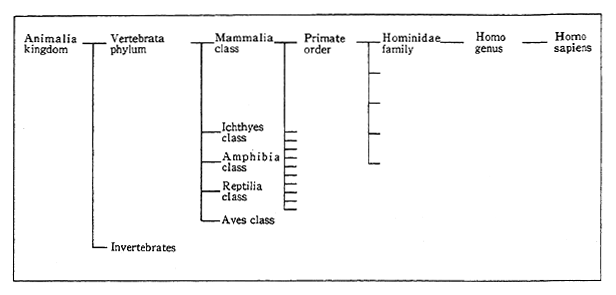
1. The Evolution and Extinction of Life
If we recapitulate the history of the evolution of life, we find that the birth of life on this planet occurred about 3.5 billion years ago. Later, it is believed that single-celled bacteria spread all across the globe. In particular, in the period approaching the Golden Age, from about 2.5 billion years ago up to 600 million years ago, it is known that cyanobacteria used the sun's light, through photosynthesis, to convert water and carbon dioxide into food and oxygen, and this prosperity, so to speak, is said to have caused oxygen pollution that resulted in the extinction of many of the other bacteria. Life, based on structural differences in the cell, came to be divided into two types, between procaryotic life forms like bacteria and cyanobacteria and the eukaryotic life forms that include man. Fossils of the oldest eukaryotic life forms have been discovered dating back 1.4 billion years. It is believed that in the process of evolving beyond bacteria, the eukaryotic life form acquired a nucleus, and then some of those cells brought bacteria inside capable of using oxygen in a symbiotic relationship, which then became the origin of the mitochondria, the director of energy production inside the cell. In this way, it is believed, the eukaryotic life forms became able to handle the oxygen that was toxic to many of the life forms of the time, and evolved toward utilization of oxygen taken from other organisms for energy production.
Fig. 1-1-2 Evolution and Extinction of Life
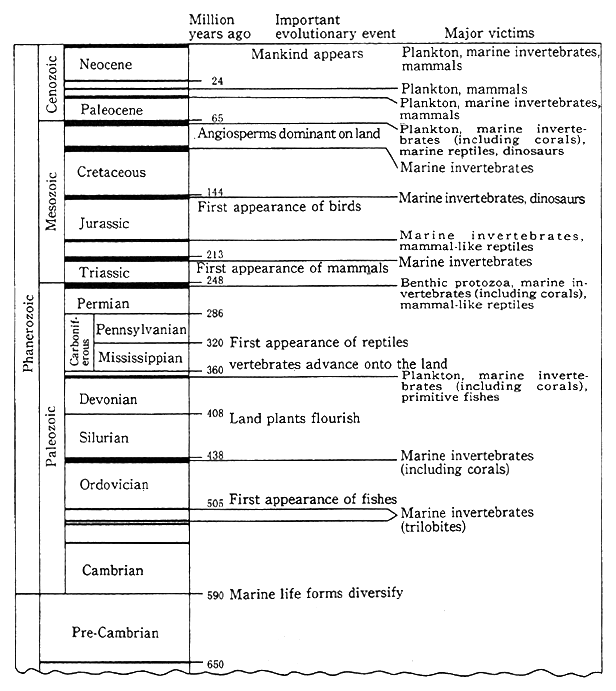
Reference: Steven M. Stanley "Extinction"
Note: Thick lines show periods of major extinctions.
Tiny life forms formed from single cells are believed to have split and multiplied to form multi-celled life forms. About 700 million years ago, vermiforms appeared, which are believed to have possessed cell groups that assumed specialized functions such as food ingestion, mobility, reproduction, and so on. By the Cambrian Period (from 600 million years ago), all of the major groups of multi-celled life forms (animal phyla) had made their appearance.
Later, after mass extinctions at about 438 million years ago, fish became predominant in the Paleozoic Devonian Period (from about 410 million years ago), while amphibians were predominant in the Carboniferous Period (from about 360 million years ago). At about 253 million years ago, there mass extinctions were experienced that extended to a number of families. At this time, the landmass is believed to have been clumped together into a single continent called Pangaea. The dinosaurs and other reptiles were predominant in the Mesozoic Jurassic Period (from about 215 million years ago). While mammals are said to have first appeared in the Mesozoic Middle Triassic (about 230 million years ago), it appears to have been a period when the reptiles through adaptive radiation expanded throughout a land zone luxuriant with ferns and gymnosperms, and into the marine and aerial habitat zones as well. Adaptive radiation refers to animals spreading into differing environments, and then through adaptation undergoing morphological specialization to create new species and diverge into new lines. While there appears to have been another mass extinction about 213 million years ago, mammals in the Late Cretaceous Period evolved into marsupials and placentalias. In the Cretaceous Period, the Australian continent that had been connected to the Eurasian continent later came to be isolated by seas, and the marsupials there began progressing through independent evolution.
About 65 million years ago, the dinosaurs and other massive reptiles became extinct, leaving a gap in the habitat space and opening up the way for mammals next to undergo an explosive adaptive radiation.
The ancestor of the primates appears to have been born about 70 million years ago in the Paleocene. Primates later evolved a somewhat larger cerebrum, and in about the Eocene, an animal was born that was similar to today's lemurs. The earliest primitive true monkey is believed to have appeared at the beginning of the Tertiary Oligocene, about 35 million years ago.
As has been seen a number of times so far, life has managed to slip through and evolve past a number of mass extinctions. There were a number of extinctions, ranging from the mass extinctions where many families would completely disappear to relatively small-scale extinctions. In the mass extinctions, in particular, the cause was in many cases a change in the environment, such as the advent of a major cooling period. While it is thought that these kinds of climatic fluctuations occurred on time scales of tens of thousands or hundreds of thousands of years, the speed of the climatic changes now being forecast by the IPCC and others appears to be comparatively faster.
Fig. 1-1-3 History of Marine Life Extinctions over the Past 270 Million Years
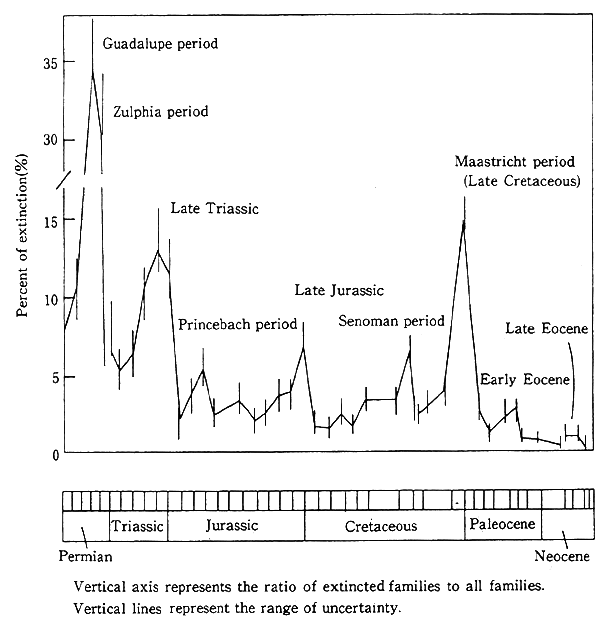
Reference: Steven M. Stanley "Extiriction"
2. Front Monkey to Man
With the history of life now coming closer to humans, let's now look at the evolution from monkeys-which first provide hints of the distinctiveness of modern man-to man. Here, we begin to see the germination of the characteristics that only man possesses.
While many of the spaces into which mammals made adaptive radiation had already been pioneered by the reptiles, there was a certain living space that a mammal pioneered independently. This was the arboreal space pioneered by monkeys.
Monkeys are said to have been born in the tropical rainforests. In the tropical rainforest, the organic biomass produced by plant photosynthesis (that is so important to animals) amounts to 30 to 40 tons per hectare annually. When compared with the four to seven tons per hectare annually in the savannah, the richness of the tropical rainforest is plain to see.
But, estimates of today's mammal biomass have it that the upper arboreal layer of the tropical rainforest supports at most about two tons of biomass per square kilometer, while the savannah reaches as much as 15 to 30 tons. This fact means that the tropical rainforest has fewer competitors. Moreover, monkeys have very few natural enemies (predators) in the tropical rainforest. While there are some complex problems concerning the acquisition of edible food supplies, when that is balanced against the competition and the low level of predators, the tropical rainforest as a habitat environment can be considered as an extremely good, comfortable location for the monkeys.
This kind of tropical rainforest has in recent years been disappearing at a rapid rate. But, that is a subject that we will look at in another chapter.
Next, let's look at the morphological adaptations of monkeys. Monkeys showed a unique morphological adaptation to arboreal life. Arboreal life requires mobility from tree to tree, and also the need to search for fruit or leaves. These requirements led to the development in monkeys of a thumb opposing the other four fingers, giving them the ability to grasp things in their fingers.
Acquisition of this ability to grasp things led to a divergence of the hands and feet. The launching point for the evolution into man is said to be the posture of walking erect on two legs. But, that requires the resolution of a number of physiological and morphological problems. For example, whereas mammals carry the torso horizontally for easy blood circulation, walking erect on two legs puts a great burden on the heart. Monkeys in the preliminary stage to walking used their hands in their forest life for food-gathering activities, assuring that their upper body took an erect stance. Moreover, life in the treetops also meant that monkeys required the ability to accurately gauge distances when leaping from branch to branch. For this reason, evolution moved toward having both eyes on the front side of the face, which allowed monkeys to gauge things in three dimensions. Furthermore, primates are said to be the only land mammals to have acquired a particularly variegated color vision.
As shown above, it appears that the divergence of hands and feet or, in other words, the acquisition and improvement in the ability to grasp things, the erect posture for the torso, and the development of vision, were basic conditions for evolution that were closely linked to the evolution of the cerebrum.
Fig. 1-1-4 Relationship between Brain Capacity and Body Weight
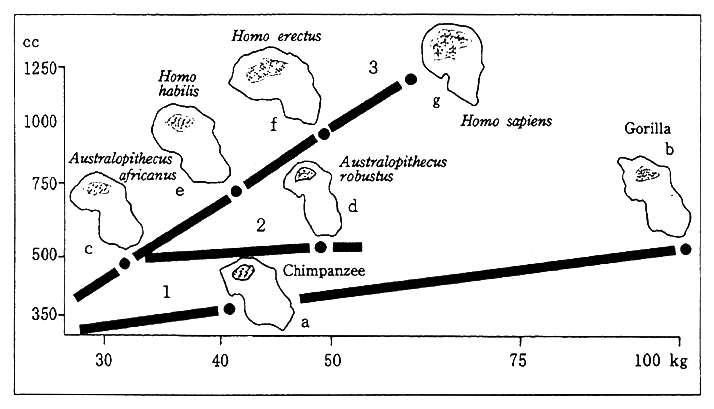
Reference: David Lambert "Prehistoric Man"
The treetops offered excellent living conditions, and the population increased. Faced with the need to deal with this increase, monkeys evolved the ability to self-regulate their population. The speed of development into adulthood slowed, each birth declined to one child, while the period between births lengthened and physiological premature births progressed. These developments preserved a relatively balanced population, and their nature made the mother and child relationship more intimate, thus forming the behavioral and societal basis for the development of sociality.
Next, let's look at the evolution of monkeys to men using the results of molecular biology.
Fig. 1-1-5 Date of Separation according to Mitochondrial DNA
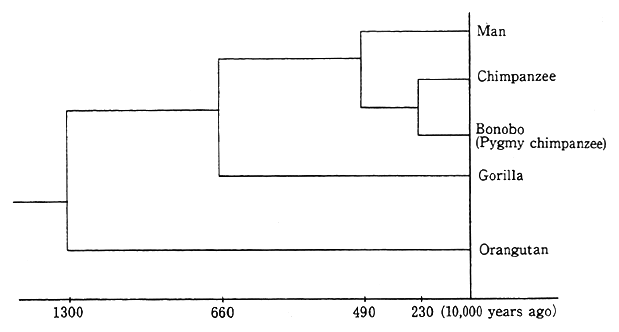
Reference NHK People's University, Masao Kawai, Evolution from monkey to man
In molecular evolution, comparison of DNA base configurations can be used to estimate the evolutionary distance between organisms. The difference in DNA base configurations between man and chimpanzee is thought to be about 1-2%, demonstrating that these two lines apparently diverged about five million years ago. In the same way, the gorilla line is said to have diverged eight million years ago, and the orangutan line 13 million years ago.
The oldest human fossil, Australopithecus Ramidus, discovered in Ethiopia in 1992, is said to be from 4.4 million years ago. If we take this and integrate it with the results of molecular evolution, then humanity can be said to have been born in Africa about five million years ago. The ecological basis for the monkey's evolution into man is said to be the advance from the forest into the savannah. One very important event that occurred was the acquisition of a new mode of mobility: walking erect on two feet.
While the forest had been a paradise for the monkeys, the savannah required the solving of such new issues as protection from powerful predators like lions and cheetahs, and hunting to acquire food. The first primitive humans solved these problems by using and producing tools (weapons), and by cooperative behavior. These developments assured their modes of living. At the same time, walking erect on two legs, the formation of families, acquisition of language, and formation of organizations all served to push progress in the direction of becoming man.
3. Speciality of Humans
As can be seen, man is like other life forms in that he arrived after an evolutionary process covering a very long time, and in this sense, we understand that he is but one more type of life form. But modern humans have an exceedingly special existence in relation to the environment. Here below, we want to throw humans and other life forms into relative relief from the standpoint of the environment concerning 1) changes in population, 2) nests (architecture), 3) standard metabolism and energy consumption, 4) food, 5) habitat density, 6) habitat region and zone of activity, and 7) efficiency of mobility, and use that viewpoint to examine the ways of modern economy and society.
(1) Changes in population and life span
1) Changes in population
The International Conference on Population and Development was held in Cairo, Egypt, in September 1994. At that conference, progress was made on international efforts to deal with population increase, including debates on important issues in the area of population, such as the integration of government policies and programs concerning the population problem and sustainable development, and the adoption of an action plan. Here, we would like to examine the sharply rising population trend of recent years in terms of comparison with other life forms.
Figure 1-1-6 depicts what is called the population curve. If there are no limitations, the population N will increase by an exponential function. In general, however, the environmental capacity K is assumed to be a certain fixed number, and as N approaches K, the rate of increase slows, sketching an S-shaped increase curve. In general, when the density of a population group rises, the so-called density effect causes the number of births and the survival rate to decline, thus functioning as an adjustment against the rate of increase, and preserving the population at that level.
Fig 1-1-6 Population Icrease Curves
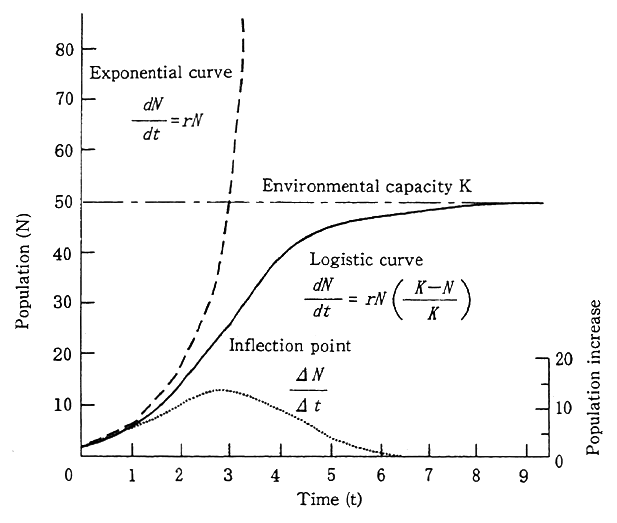
Reference: Nobuo Egami, Tetsuo lino, eds., "Biology"
Figure 1-1-7 shows the human population increase. Based on ideas like those expressed in the above statement, the environmental capacity for humans was predicted (in 1936) to be about 2.64 billion people. At the present time, however, the population is at a level far surpassing that point, and is moving on a rising trend. It would appear that humans have overcome all types of limiting factors, and have succeeded in raising the environmental capacity.
The adjustments that are required when a population increase surpasses the environmental capacity are thought to be of three types, as shown in Figure 1-1-8. In other words, there is the pattern where the extent of population fluctuation becomes steadily smaller as adjustment progresses, the pattern where the extent of fluctuation continues at a fixed rate after the environmental capacity has been exceeded, and the pattern of unstable fluctuation, whereby the population crashes after exceeding the limit. Moreover, in one experiment involving drosophila flies, worsening food shortages and other factors apparently led to an absolute population decline in one fell swoop.
Fig 1-1-7 World Population Increase Curve
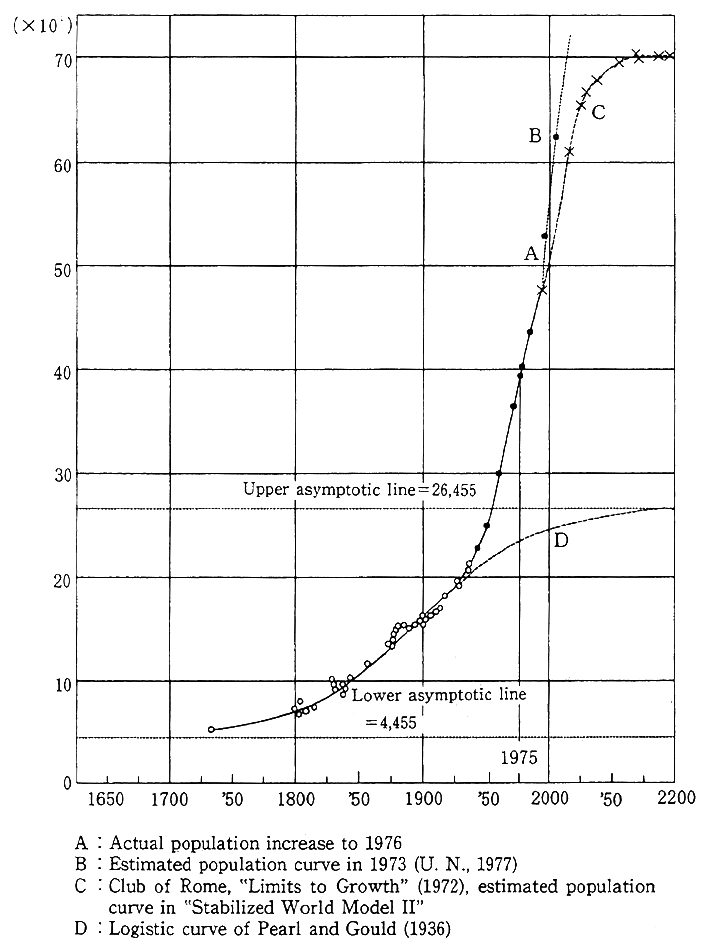
Reference:Nobuo Egami, Tetsuo Iino, eds., "Biology"
1-1-8
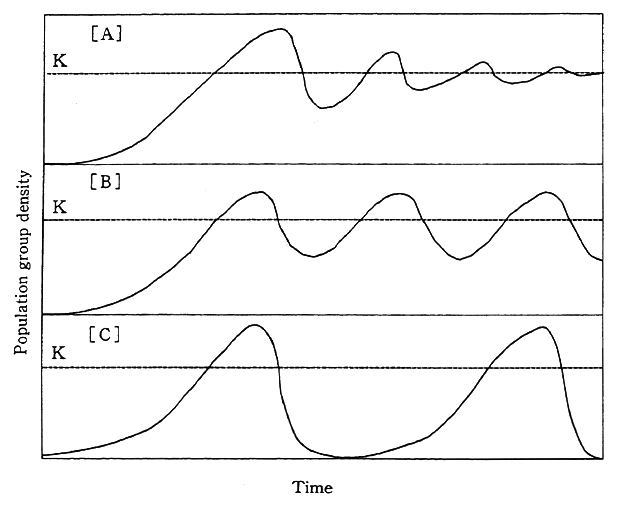
Reference:Whittaker R. H."Communities and Ecosystems"
Next, let's look at the survival rates of life forms with the survival curve. Figure 1-1-9 gives examples of survival curves for three different species. In general, species with a lot of eggs (offspring) have very high mortality rates for the infancy stage, while species with few eggs tend to have lower mortality. Figure 1-1-10 shows the survival curve for humans. In the Stone Age, it appears that about half the population were dying by the age of ten years or so. In modern-day Japan, however, that has risen to about 75-80 years of age.
2) Life span
Are there any special characteristics in the life spans of human populations? As can be seen from Figure 1-1-10, humans have been steadily extending their life span. For example, the figure shows that in the course of several tens of thousands of years between the Stone Age and Modern Japan, the life span of the population has multiplied in length. The reasons for that are assurance of a stable food supply, advance of medicine, and so on. One distinctive aspect of humans therefore comes as a result of the drop in the infant mortality rate, which has lengthened the life span and slowed the rate of decline for the population as a whole.
Fig. 1-1-9 Various Survival Curves (Ito, 1978)
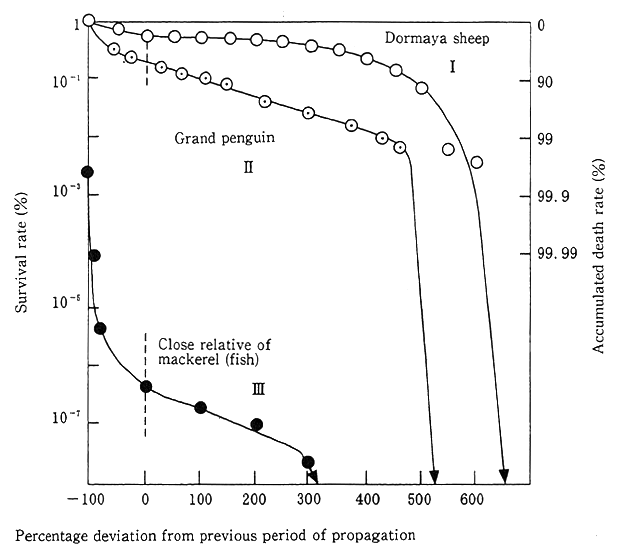
As is particularly apparent in recent times for developing countries, a rising birth rate, a slowing rate of decline for the population as a whole, and a lengthening life span can result in an explosion in population growth. This is the kind of situation that led to the above mentioned International Conference on Population and Development to state, "We must assess human fragility in environmental change, determine which are the ecologically fragile regions that are exposed to population pressure and monitor those regions, accommodate the experiences of indigenous peoples in the management of ecological systems, and conduct surveys to develop policies that promote more harmonious preservation of the ecological systems that must be relied upon for human needs for the long term."
Fig. 1-1-10 Survival Curve for Number of Survivors Per 1,000 Births
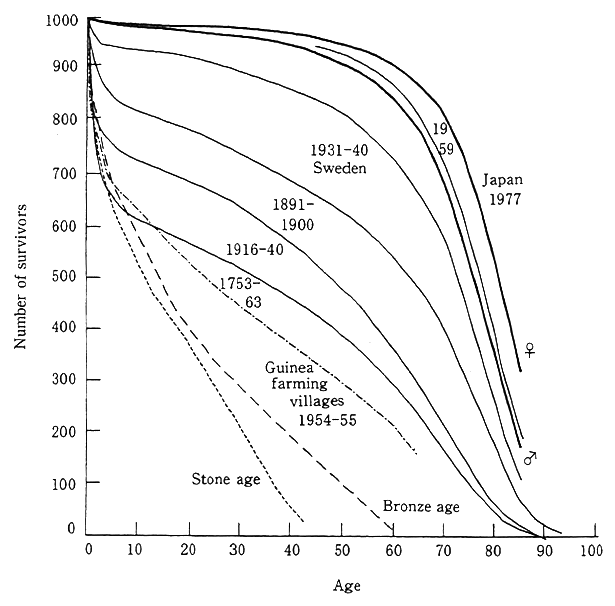
Diagram prepared from:
Japan (thick line, males, females), Abridged Life Table 1977;others,
Colin Clark (1967), Population growth and lane use, MacMillan
Reference.: Nobuo Egami, Tetsuo Iino, eds., "Biology"
(2) Nests and architecture
Next, let's look at the dwellings of humans and other life forms. In general, nests of life forms are made so that the outward appearance is as unobtrusive as possible within the environment. In other words, it is thought that the necessity for a species to avoid the notice of predators is what makes it all-important to melt into the natural landscape. Human architecture, by contrast, or at least modern architecture, has a different purpose than the nests of these other life forms. It is believed that when humans were using residential architecture built exclusively under their own power, the residences were not conspicuous. Modern architecture, however, such as the high-rise apartments built with the use of large-scale construction equipment, is massive, complex, and could be considered to be designed as conspicuous. This has meant that, even among the massive architecture seen in Japan, it is not difficult to find patches of natural scenery like scattered islands. Maintaining operation of this kind of modem economic society requires a fair amount of energy. While a simple comparison is probably impossible, let's turn for a minute to the termites of Africa and elsewhere. Termites build a termite mound, within which several million individuals are said to live. The massive size of the termite mound, which as a result is easily recognizable from outside, can be offered as an example of the same kind of distinctiveness that humans possess. The really interesting point about the termite mound is that it is said to be equipped with the capability to maintain temperature at an even level and to cycle air from the outside to prevent the mound from filling up with carbon dioxide gas (Figure 1-1-11). So while we consume massive amounts of energy to run. the air conditioning systems used in our buildings and underground structures, the termite nest can be said to achieve the same function without placing any burden on the environment.
Fig. 1-1-11 Termite Air Conditioning Systems
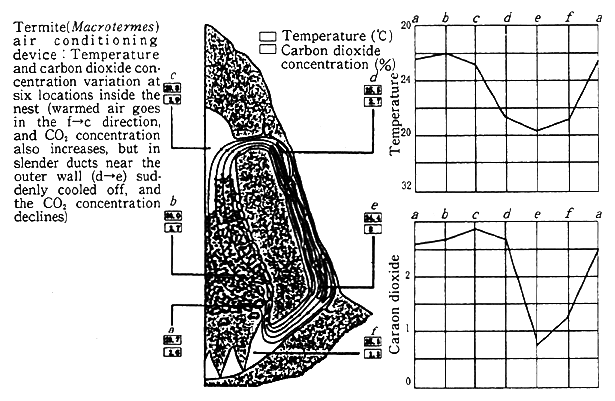
Reference : Atsushi Hasegawa,"Architecture of Living Things"
(3) Humans viewed in terms of standard metabolism and energy consumption
Let's look at humans in terms of standard metabolism. The standard metabolism is the amount of energy consumed when in a rest state, and is generally expressed in terms of oxygen consumption per unit of time.
When we investigate the standard metabolism of warm-blooded animals, and view their relationship according to weight (Figure 1-1-12), we begin to see a fixed line of relationship. Humans, too, can be found directly on this line, as well. So humans have the same existence as other warm-blooded animals.
Fig. 1-1-12 Relationship between Metabolic Rate and Body Weight (Mammals)
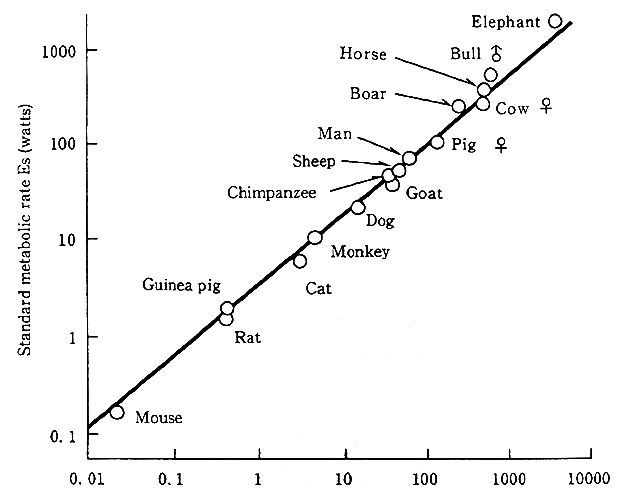
Reference: Tatsuo Motokawa, "Elephant's Time, Rat's Time"
But looked at in terms of energy consumption, it is plain that humans partake of an extremely singular existence.
For the global average value, humans consume about 130 watts of energy from food supplies. Moreover, special non-food energy consumption amounts to about 1,800 watts of primary energy consumption. While it is impossible to completely compare the energy used by humans with that used by other animals, in the case of the Japanese, primary energy consumption is about double the world average value. When we consider that the standard metabolism is about 2,000 watts, an animal with the same standard metabolism would weigh about four tons. Compared with other species, the rate of energy consumption is thus very high.
The standard metabolism increases by about ten times in the evolution from single-celled to multi-celled organisms, and from cold-blooded to warm-blooded animals (Figure 1-1-13). In this sense, since the energy consumption of modern man is one magnitude larger than other warm-blooded animals, it can be pointed out that the life form called modern man has become an essentially different life form from other animals.
(4) Food
Being able to assure a stable supply of food is important for animals in maintaining their species. In the competition between animals for food, competition with other species is avoided wherever possible. And when competition does occur, it can be considered a method for forcibly developing more effective utilization of resources. This competition appears to have resulted in a variety of eating habits and digestive structures and functions for animals.
Animal nutrition systems took shape through a long history of mutual reactions between the animals and their food. Animals resolved many difficulties to occupy a stable position (niche) in the ecology. In other words, animals evolved in their eating habits as well for the survival of their species.
As we have seen, each animal determined what they would eat, by species, and in many cases developed inherently worthy nutrition systems. It goes without saying that humans, too, require food (Figure 1-1-14).
Fig. 1-1-13 Relationship between Metabolic Rate and Body Weight
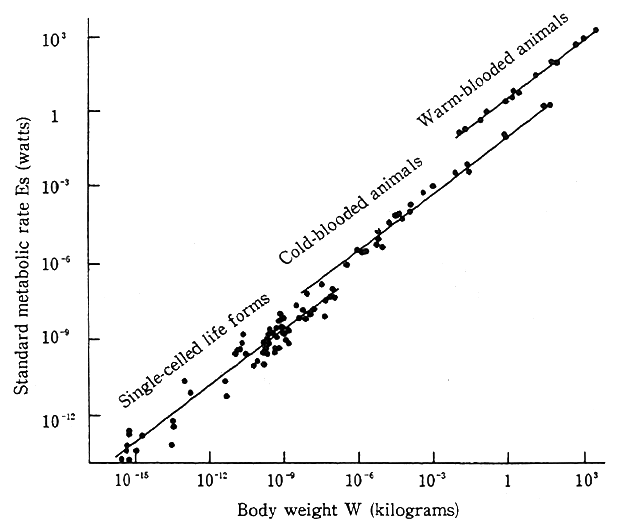
Reference: Tatsuo Motokawa, "Elephant's Time, Rat's Time"
Humans acquired eating habits not seen in other animals. They subjected their food to such cooking and processing activities as steaming or frying, and so greatly expanded the range of edible foods. Moreover, it is believed that the creation and utilization of tools and weapons, and the use of farming and animal husbandry, assured stable supplies of food. Humans have altered nature on a huge scale, using farming and other occupations to provide food.
Moreover, cooking and the acts of eating and drinking generate waste water and leftover food, both of which put significant burdens on the environment.
Humans are a single species that consumes an exceptionally large ratio of the vegetable production on the planet. Compared with the share held by other life forms, this condition, too, could be considered an extremely singular position.
Fig. 1-1-14 Food Chain of Land Animals
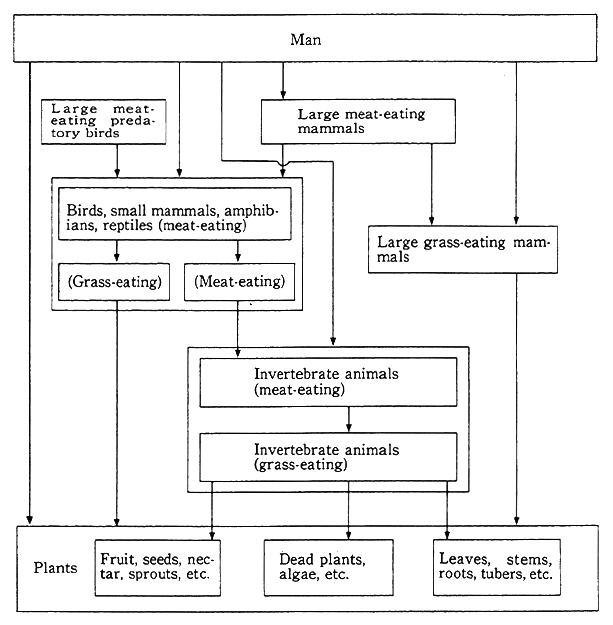
Reference: Altered from Sadayuki Hoshino, "Human Nutrition, Animal Nutrition")
(5) Habitat density
Next let's look at habitat density. In general, habitat density is said to be in reverse ratio to body weight. In mammals, the habitat density is believed to have a relationship of 55W-0.90 (individuals/km2 (W equals body weight in kilograms)). For example, assuming a human weighs 60 kilograms, the habitat density for a single organism is predicted to be 1.4 people/km2 But the actual world average value is 39 people/km2, a number about 28 times higher. Furthermore, the population density in Japan was 327 people/km2 in 1990, which, compared with the predicted value derived from the generally accepted relationship between body weight and habitat density, is an extremely high number.
Fig. 1-1-15 Expansion of Human Habitat
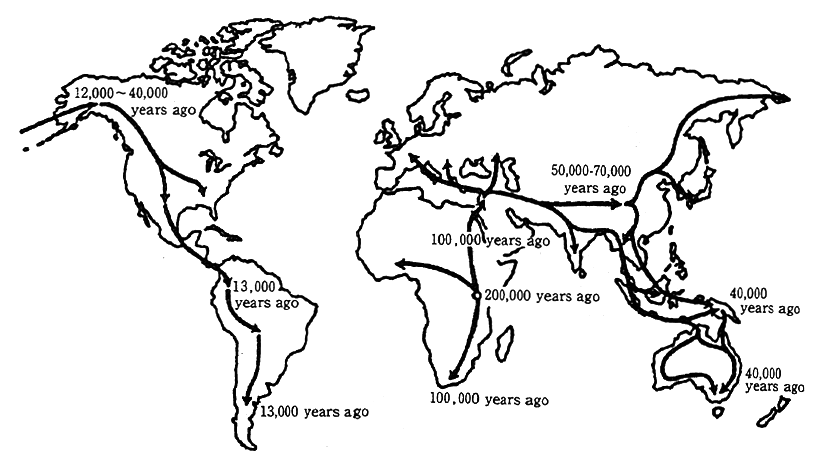
Reference: From "Kagaku", Vol. 60, No. 2,1990, by Nei
Fig. 1-1-16 Distribution of the Great Apes
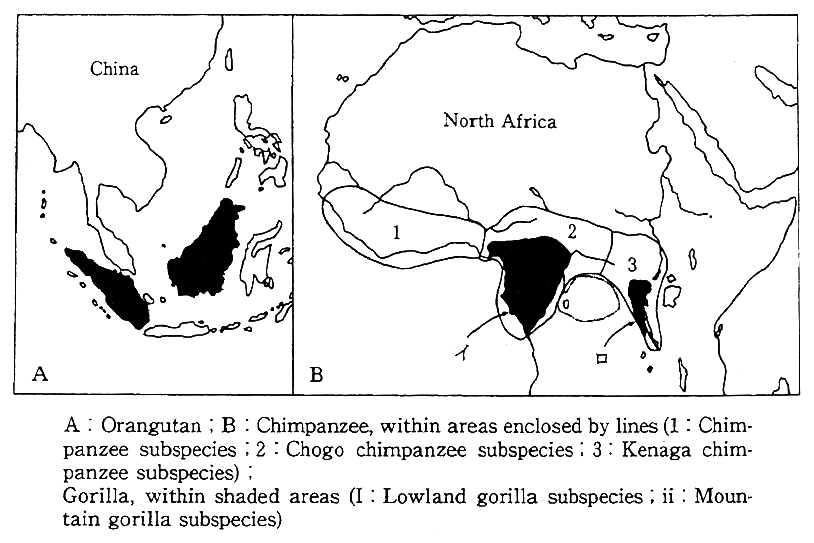
Reference: Masao Kawai, Mitsuo Iwamoto, Kenji Yoshiba,"Monkeys of The World"
(6) Habitat region and zone of activity
Humans survive in an extremely large number of regions in the world today, and there are very few other life forms that exhibit such a wide range of habitat regions in a single species.
Next, let's look at the zone of activity. In general, mammals' zone of activity is said to be in the relationship of 0.154W-1.06 (km2). If we apply this formula to man, the calculation comes to about 12 km2, equivalent to a circle with a radius of about 2 km, which is a distance that can be walked across in about 30 minutes. This is a number that has no bearing on the actual situation in modern Japan.
(7) Efficiency of mobility
To compare how much energy is used when moving the body by either running or flying, calculation of the energy (conveyance cost) required to move one kilogram of body weight one meter reveals an exponential ratio of -0.3 to the body weight, resulting in a straight line relationship descending down and to the right (Figure 1-1-17). From this, we understand that the larger the size of the animal, the lower the conveyance cost per one kilogram. While Flying in the sky is more economical than moving on the ground, the cost of swimming through the water is more economical than either. Humans, in addition to walking or running on their own power, also can use riding things to move about. If we look at passenger cars or aircraft, a person riding alone in a passenger car consumes about 40 times the energy to move than an animal of the same weight, a very poor efficiency rate for mobility. Of course, of all the riding things invented by humans, we understand that bicycles have an efficiency that is not the least bit inferior when compared to the mobility of other life forms.
Fig. 1-1-17 Economy of Movement Comparison
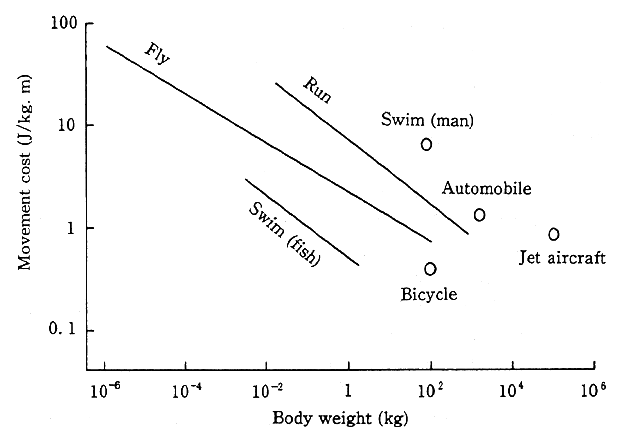
Reference: Tatsuo Motokawa, "Elephant's Time, Rat's Time"
4. As One Species of Life
Many species have over long periods of time adapted their body morphologies to changes in environments. Human-caused changes to the environment, however, have proceeded far faster than the speeds required for these life forms' morphological adaptations. But as we have seen, humans are one more species of life and so are exactly like other life forms in that they are unable to adapt to the rapid changes they themselves are making to the environment by using the method of changing their own body morphology.
Humans are supposed to have improved their living conditions in concert with evolution. For example, Pithecanthropus is conjectured to have invented simple stone tools and used them to increase the amount of game taken and to economize on the labor needed to take game, thus making his life easier. And Homo Erectus used stone tool production technology that went one step further, adding blade surfaces to the stone tools while at the same time successfully making fire. In the transition from Old Man to New Man, tools became diversified and technology more elaborate, and it appears that a prosperous, spiritual life developed. In the New Stone Age, primitive farming and animal husbandry appears to have begun alongside the older game hunting. Farming and animal husbandry continued to advance as times moved forward into early antiquity, and modes of life changed drastically as stone tools were replaced by the invention of metal tools. The development up to modern times of all kinds of metal tools has made us recipients of the prosperity of life in certain areas.
We are recipients of this prosperity, and have seen explosive growth in our population. The downside is that we must not forget that as many as 50-150 species are said to be going extinct every day. We too have not changed at all in the need for the blessings of an excellent environment, in the form of clean water, air, and food. When we consider the present state of affairs where so many species are going extinct, we humans need to be carefully thinking about how to respond.
All life forms are members of the ecological system, and have entrusted themselves to the balance and harmony of the system. Humans, however, have slipped out from the system to rely on a society and civilization that they themselves built. Moreover, the activities of this society and civilization have reached the point that they have strength enough to cause irreversible damage to the environment. And this possibility has snuck up on humans themselves without their even knowing it. Humans are perhaps the only life form capable of thinking about what will happen to future generations, and to act accordingly. What should those of us who are alive today do? What kind of response will we have for this question, which concerns the survival of the species?
In the next section, we would like to examine the relationship between civilization and the environment, to further the search for the location of humans.
Section2. Ancient Civilization and the Environment
In Section 1, we saw that humans were simply one species of life form within the global ecosystem, but nevertheless possessed properties largely different from other ordinary life forms, including the remarkably rapid increase in numbers of individuals (population) and the remarkably large amount of energy and resources consumed, and therefore also had a big influence on the environment. But this was not a characteristic that humans possessed from their beginnings several million years ago, rather, it is particularly characteristic of humans after the commencement of agriculture and the possession of civilization. In this chapter, we shall look at the humans who attained civilization, with a particular focus on ancient civilization, to see how they interacted with the environment in terms of their use of the blessings of the environment and their influence on the environment, and look at what we can learn from the relationship between the environment and the rise and fall of ancient civilizations in our dealings with modern environmental problems (Figure 1-2-1).
Fig. 1-2-1 World Population Trend from 10,000 B.C. to 200 A.D.
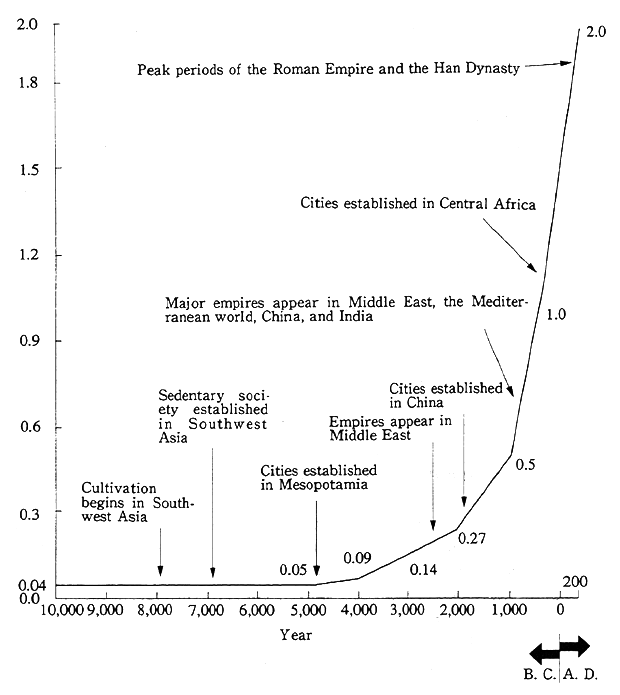
Reference: Clive Ponting,"A Green History of The World", 1994
1. A History of the Rise and Fall of Ancient Civilizations
We do not always clearly understand the relationship between the environment and the rise and fall of ancient civilizations, and the various opinions offered will not necessarily always be in accord. Nevertheless, it is believed that environmental changes had an effect on the rise of civilization, that the activities of civilization had an effect on the environment, and that in a number of civilizations, at the very least, the environmental change that the civilization itself brought on was a major cause of those civilization's extinction.
Here follows a number of examples of past civilizations that we shall introduce based on a bibliography built up over the years from research results in both Japan and abroad, and shall consider in terms of the relationship between the environment and their rise and fall.
(1) Sumarian (Mesopotamian) civilization
Sumarian civilization is one of the oldest civilizations, with the first confirmed remains of communities in the southern part of Mesopotamia dating back to around 5300 B. C. This civilization is believed to have arisen in the often flooded drainage basin of the Tigris and Euphrates rivers (Figure 1-2-2). In Mesopotamia, riparian irrigation cultivation arose in the Ubaid Culture of about 4300-3500 B. C. Later, a number of communities were formed that would become the origin of a number of cities, and by the latter half of the Uruk Period (3500-3100 B. C.) the number of communities had increased and were progressing toward becoming cities. While the Uruk Period had supported food production with small-scale irrigation cultivation derived from voluminous amounts of water, it is said that in the Early Kingdoms Period (2800-2700 B. C.) the climate began to dry out. The many branching watercourses declined in number, while the main water course became straighter, with the result that it became necessary to use artificial canals to bring water to the unwatered land. It is believed that this need for irrigation led to the advent of large-scale civil engineering works, and the result was the birth of a large-in-scale, highly advanced society. At the same time, the number of small-scale communities declined as the farming population from the hinterlands gathered into the cities so that, in the midst of this expansion, a large-scale city arose at Ur in the southern part of Mesopotamia, at around 2700 B. C. But with the progressively dryer climate, irrigation continued to be practiced, and salinity in the irrigation water steadily accumulated in the soil as residues from water evaporation. Progressive salinization resulted in the steady decline of poorly saline-resistant wheat from about 2000 B. C, and in a switch to barley, until the only food that appears to have been cultivatable was the highly saline-resistant date palm. In addition, forests in the upper reaches of the drainage basin were being cut down, accelerating soil erosion, and soil washed away by the river and deposited downstream appears to have blocked up the irrigation watercourses. This silt is also thought to have been highly saline, thus accelerating the damage caused by salinization. While the barley harvest in about 2400 B. C. averaged 2,537 liters per hectare, comparable to the productivity in modern-day United States and Canada, productivity 300 years later had fallen to about 40% of that average, and by 1700 B. C, the harvest was 897 liters, no more than 35% of before. By 2000 B. C, when the decline in the barley harvest was becoming obvious, the last Sumarian Empire had already collapsed; 300 years after that the center of power had passed northward to Babylonia, where there was no saline damage. It is believed that while surplus production of barley, the main food source for the Mesopotamians, had supported the existence of people living in an urban civilization, a decline in production due to saline damage caused the surpluses in the main food source to disappear, and the Sumarian culture in southern Mesopotamia to decline. (Sources: Clive Ponting, A Green History of the World; Takeo Yuasa, The Environment and Civilization)
Fig. 1-2-2 Map of Ruins in Mesopotamia
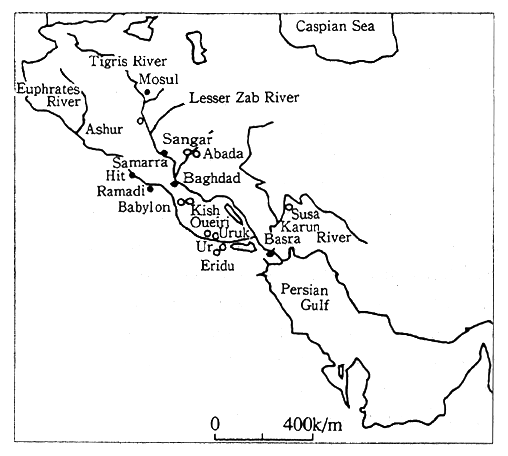
Reference: Takeshi Matsumoto, "The Rise and Fall of Mesopotamian Civilization and Environmental change," in "Ancient Civilization and Environment"
(2) Cretan civilization
The island of Crete emerged as one of the cultural centers of the Mediterranean Sea at about 2000 B. C, a development that is said to be related to the wood shortages in the advanced civilization region of Mesopotamia (Figure 1-2-3). For example, although wood was an essential item for the construction or repair of palaces, and for heating buildings or cooking, the development of civilization in Mesopotamia had been accompanied by a decline in forest resources. The island of Crete, which at that time is believed to have still possessed forests, is thought to have become a major wood supply base for Mesopotamia, a situation that brought great wealth to Crete and no doubt led to the flowering of a Cretan civilization centered on Knossos. Although Knossos was at one time destroyed by a massive earthquake, the rich forest resources at that time helped the city to rebuild, and the sudden growth is said to have caused the population of Knossos to increase by about 28 times over 1,000 years earlier. This population increase is believed to have joined with the development of civilization to increase the consumption of wood, resulting in the decline of the forests, so that even Knossos, whose growth had been backed by rich forest resources, began to suffer from a shortage of wood. Knossos went into decline, partly as a result of the decline of its forests, and the center of civilization shifted to Mycenae in southern Greece, which is believed to still have at that time in possession of forests.. (Figure 1-2-4). (Source: John Perlin, A Forest Journey The Role of Wood in the Development of Civilization)
(3) Greek civilization
It is presumed that Greece possessed forests when the Myceneancivilization got its start at about 1550 B. C. But with economic expansion in the Late Bronze Age of the 13th century B. C. an increase in population is thought to have led to an expansion in demand for wood resources, while an expansion of agricultural land appears to have caused forests to decline in the Messenia region, which was the center of the Mycenaean civilization, and in other parts of the Peloponnesian Peninsula. Civilization then appears to have gone into decline, partly due to the decline of the forests, and the population of the Messenia region is estimated to have declined by 90% from the 13th century B. C. to the 12th century B. C. Thus, the center of Greek civilization moved away from Greece proper to Asia Minor, where forests are presumed to have still existed.
Port cities such as Miletus and Ephesus prospered from about the 7th century B. C, but here, too, the increase in population and expansion of agriculture appears to have led to a decline in the forests, accelerating erosion of the soil and washing it away down the rivers. At Miletus and Ephesus, both located at river mouths, the soil was deposited in the harbors, accelerating the creation of marshy land, and the ports facing the sea were left stranded further and further inland. So the prosperous port cities declined as well.
Fig. 1-2-3 Map of the Bronze Age World
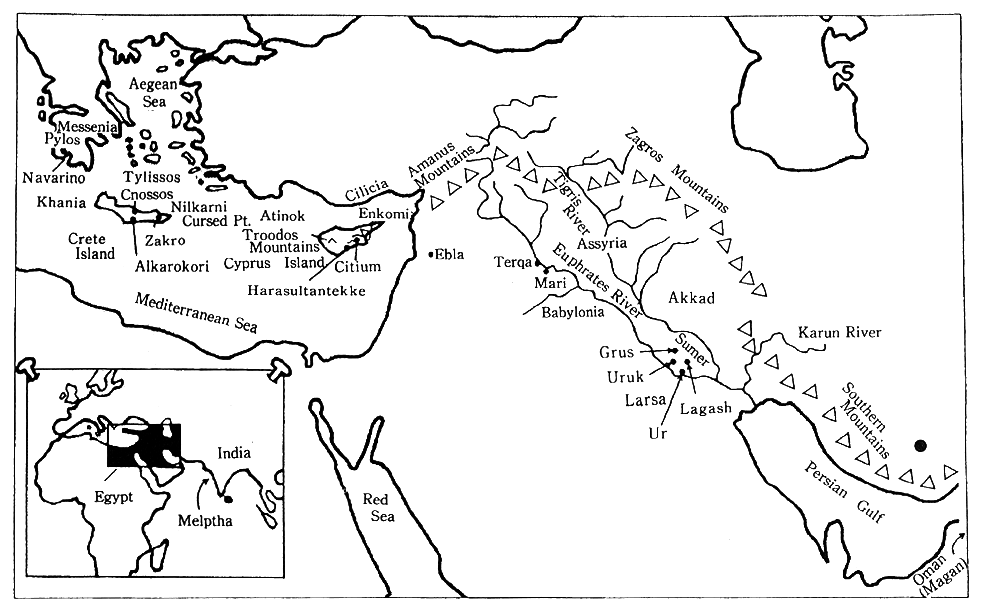
Reference:John Perlin,"A Forest Journey:The Role of Wood in the Development of Civilization"
Fig. 1-2-4 The Mediterranean World in the Mycenean Age
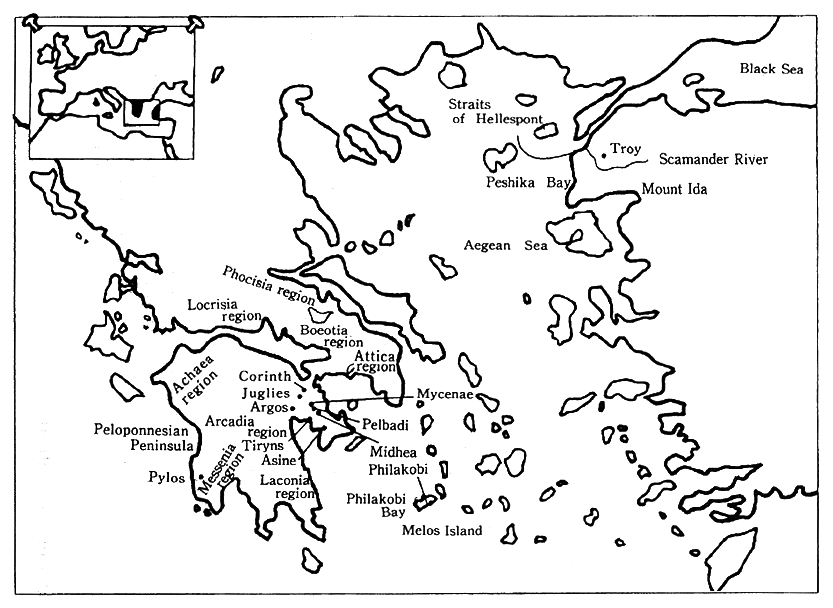
Reference: John Perlin, "A Forest Journey: The Role of Wood in the Development of Civilization"
With the population dispersed toward Asia Minor, the forests in Greece proper appear to have recovered by the 8th century B. C. Supported by these forests, civilization also underwent a revival in Greece proper, a development that could be considered to be linked to the flowering of Athens. While the Golden Age of Athens came after the Persian War, it was the Athenian navy that played an important role in the victory in the Persian War and in the leading position that Athens assumed in the Greek world after that time. Wood was probably a necessary resource in the construction of the fleet, in the refining of the silver used to pay for those costs, and in the restoration of Athens after it was destroyed by the Persian army. Athens prospered in the years following the Persian War backed by the strength of its naval forces. But with growth came a rising population, demand for charcoal used for heating and cooking increased, and it appears that forests steadily declined in the Attica region. This trend is thought to have been accelerated by the Peloponnesian War. Greece in the latter half of the 5th century B. C. was divided up by two major powers, Athens and Sparta, and was erupted between these two. At the time, wood is presumed to have been particularly important for the naval power that was Athens. For this reason, the Spartan army appears to have invaded the Attica region as soon as the war started and to have cut down the forests. As the war dragged on, the decline in the forests accelerated, until both Athens and Sparta were exhausted at the end of the long war, and supremacy in the Greek world shifted northward to Macedonia, which is presumed to have possessed forests. (Figure 1-2-5) (Sources: John Perlin, A Forest Journey: The Role of Wood in the Development of Civilization; Takeo Yuasa, The Environment and Civilization)
(4) Roman civilization
When Rome got out from under domination by the Etruscans and set up a republican government (in 509 B. C. according to tradition), Rome is presumed to have been in possession of forests. At this time, while Rome appears to have been exporting wood and importing various products from more advanced civilized regions such as Greece (Figure 1-2-6), the forests surrounding Rome soon declined due to expansion of residential districts. In the 3rd century B. C. extensive stock-farming and intensive garden-style agriculture were introduced, and expansion of agriculture is thought to have led to a further retreat of the forests. This situation was first reflected in Roman life in the form of rising prices for fuel, which reason it is said led Cicero, the most famous orator in Rome, to call for protection of the forests. Rome, however, appears to have opted for conquest as the way to replenish its wood. So one factor lying behind the Roman expansion of conquering the surrounding districts one after another and incorporating forests into its own territory could be considered to be this kind of demand for wood.
Fig. 1-2-5 Greece and Asia Minor
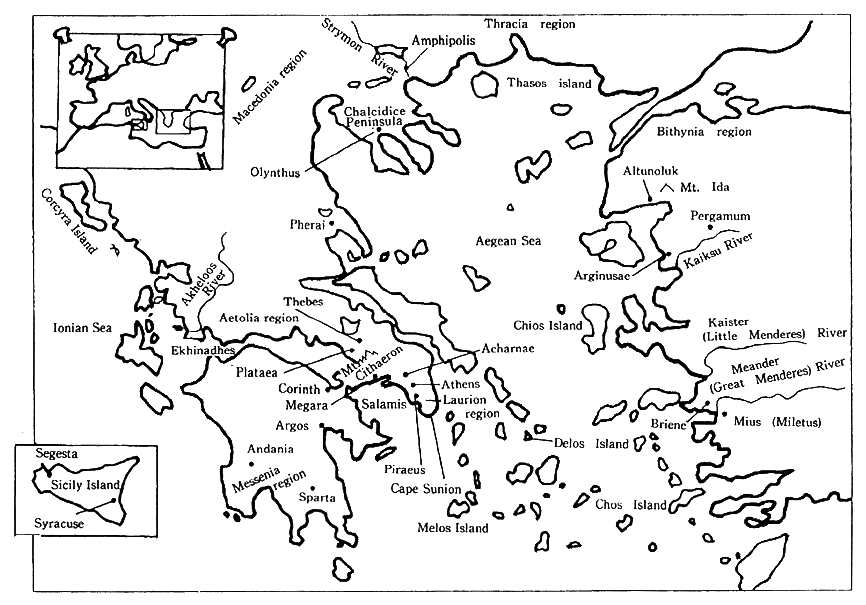
Reference: John Perlin,"A Forest Journey : The Role of Wood in the Development of Civilization"
Rome, which started from a single city-state, began with the Development of Civilization" conquest of Italy, then conquered Gaul, Iberia, North Africa, Greece, and Asia Minor, becoming a great empire dominating the entire Mediterranean Sea. As this expansion continued, the central city of Rome flourished and became a giant metropolis. In this city, wood is assumed to have been consumed for construction or heating of buildings, and for the glass industry and others. While the financial foundation for Rome's growth lay in silver from Spain, wood was required as fuel for refining the silver, which can be considered the reason for the extensive cutting of forests in Spain, as well. Partially due to this cutting, silver production went into decline, and a Rome faced with financial difficulties apparently took various measures to forestall financial ruin, most of which involved restricting the freedom of the citizens such as requisitioning foodstuffs and other necessities for rationed distribution. For this reason, the wealthy aristocratic class wthdrew to large agricultural estates in the countryside, leaving only those citizens who had lost their land and were living off the ration distribution. In addition, it appears that possession of large estates by absentee landlords led to ineffective management of agricultural land that caused productivity to decline. By the 4th century, Rome had come to rely on North Africa for its foodstuffs, and the city was in fear of food shortages whenever the seas became a little rough. These food shortages are thought to be one cause of the rising societal chaos and, in the midst of that, the giant empire collapsed. (Sources John Perlin, A Forest Journey The Role of Wood in the Development of Civilization; Takeo Yuasa, The Environment and Civilization)
Fig. 1-2-6 Italy in the Roman Age
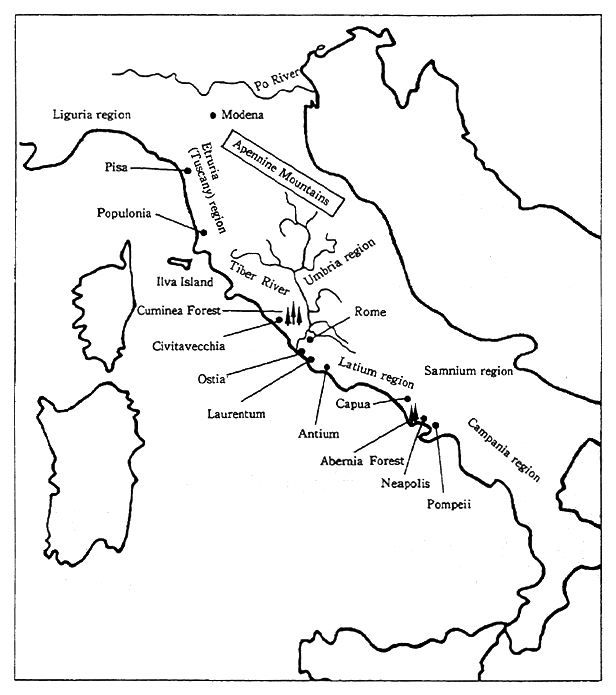
Reference: John Perlin,"A Forest Journey : The Role of Wood in the
(5) Egyptian civilization
Egypt is often called the "Jewel of the Nile." The history of Egyptian civilization appears to have unfolded in a green belt about 10-20 kilometers wide on both sides of the Nile, which pierced a river valley through the desert (Figure 1-2-7). Although the Nile repeatedly underwent periodic flooding, the floods were mild and, helped by the fact that both banks of the Nile were flanked by cliffs, did not sweep everything away like the massive floods seen around other major rivers. Egyptian civilization was built on top of the fertile soil brought by the annual periodic flooding of the Nile. Under these conditions, Egypt has maintained harmony with the natural environment through 7,000 years of civilization right up to the present century.
Fig. 1-2-7 Map of Egypt
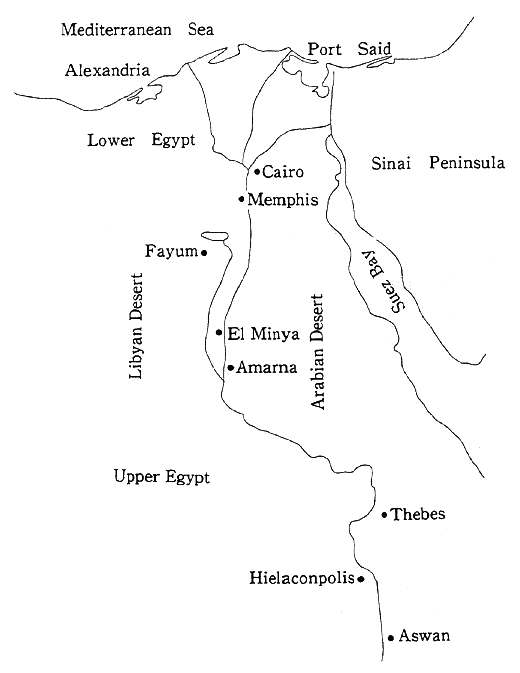
Reference: Takeshi Matsumoto,"The Rise and Fall of Mesopotamian Civilization, and Environmental Change, in Ancient Ci vilization and Environment"
In the districts on the upper reaches of the Nile River, corresponding to Ethiopia and Uganda today, the most rains fell every year in June, causing floods in Egypt in September, about 300 kilometers away. The floods, bringing fertile new soil to every part of the narrow Nile Gorge, ended by November, and it was during this season that the autumn crops were sown (Figure 1-2-8). There was no saline accumulation because the underground water table in the Nile Gorge was more than three meters below the ground surface during the month-long floods, while the annual supply of fertile silt and water is believed to have maintained the soil. Because this system never required dirty utilization of the natural conditions, or complex technologies, it was introduced into ancient Egypt and then continuously used thereafter without much change. The soil was so rich that the crop productivity of the Nile Gorge in the 18th century was double that of France for the same period. (Sources: Clive Ponting, A Green History of the World ; Takeo Yuasa, The Environment and Civilization)
Fig. 1-2-8 Cyclical System of Ancient Egyptian Civilization
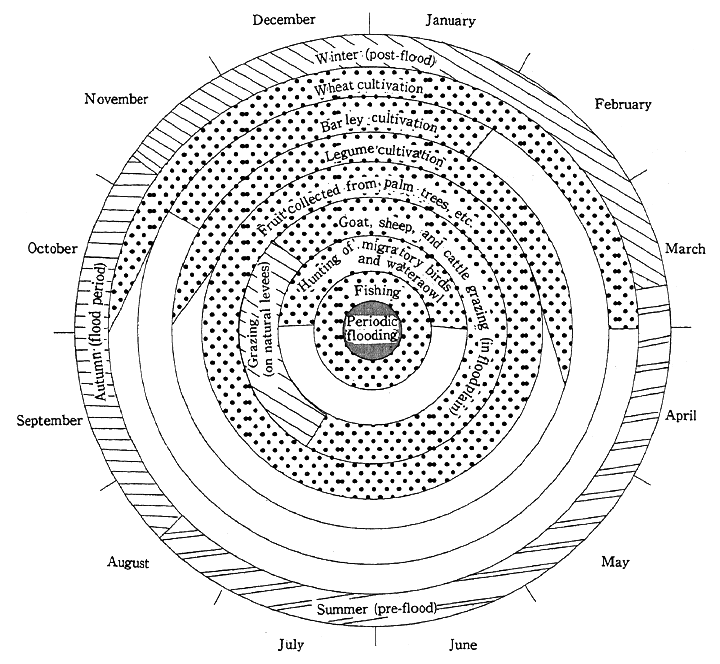
Reference: Yoshinori Yasuda,"Jomon Culture in the History of the World"
(6) Indus civilization
The Indus civilization appears to have started as an urban civilization at about 2500 B. C. Its center is believed to have been in the Sind region of the Indus River drainage basin, at Mohenjodaro (Figure 1-2-9). As can be seen by the Mohenjodaro ruins, the cities of the Indus civilization were built based on well-ordered plans. It is believed that flood irrigation agriculture centered on winter crops is what supported this urban civilization. In other words, it was a method that, in expectation that the Indus River would slowly expand its river width and spread water in a broad flood, involved the building of weak levees that when swept away by the water would leave behind accumulations of silt, at which places crop cultivation would take place. It would appear that this system was an agriculture more suited to the Indus environment than irrigation would have been.
This Indus civilization went into a period of decline from about 1800 B. C., and was destroyed by 1500 B. C. Various theories have been offered to explain this, including the intrusion of an alien people (Aryans), major flooding, shifts in river channels, or environmental effects. The theory involving climatic change is as follows.
Fig. 1-2-9 Formative Period of the Indus Civilization
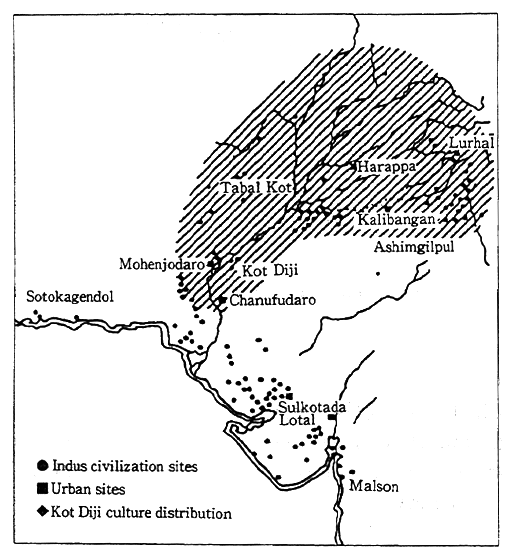
Reference : Hideo Kondo,"The Rise and Fall of the Indus Civilization, and Environmental Change," in "Ancient Civilization and Environment"
More than 5,000 years ago, the climate turned colder, causing the snow accumulation on the Western Himalayas to increase. At the same time, the summer southwest monsoons failed to appear, and the middle and lower reaches of the Indus River drainage basin, such as the Punjab plain or the Rajasthan plain, dried out. As the drying trend occurred, people searching for water congregated on the banks of the Indus. At this time, the rivers flowing out of the Himalayas showed increased flows in early spring due to large snow melt coming off the increased snow accumulation. This allowed the development of flood irrigation agriculture centered on winter crops, and an urban civilization rapidly took form. While details about climate change are not known for the time when the Indus civilization entered a period of decline, about 3,800 years ago, it is thought that the Eurasian continent again entered a warming period about this time, which would have reduced the water flow of early spring and dealing a heavy blow to the agricultural society dependent on it. This is believed to be one factor in the decline of the Indus civilization. (Sources Yoshinori Yasuda, The Decline of the Climate and Civilization; Takeo Yuasa, The Environment and Civilization)
(7) Chinese civilization
Chinese civilization has always been said to have begun as a Yellow River civilization, and yet there was a rice cultivating civilization in the Yangtze River at a far earlier time. In the 1970s, at a site being excavated in Homudu, Zhejiang province, there were unearthed remains of residences, a warehouse, and rice from 7,000 years ago. Moreover, Liangzhu, near Homudu, was producing advanced crafts centered on jade implements, and appears to have been an urban civilization centered on rice cultivation that was flourishing 5,300 to 4,200 years ago. Since one characteristic of rice cultivation is that it requires vast amounts of water, forests that can store and supply water are thought to have coexisted with the rice cultivation. Later, however, the civilization is said to have been destroyed by invasion from the north.
In the Yellow River drainage basin, meanwhile, agriculture centered on field cultivation commenced in a serious fashion in the Yin Period, in the 14th century B. C. While it is believed that the area was then under the same dry climatic conditions as exist today, farmland is thought to have developed in river drainage areas on the margins of the hills where the soil contained relatively high water content. Farming at that time was utterly dependent on rainfall, and the crop produced was mainly drought-resistant millet. The Yellow River contains a massive amount of yellow earth, which sinks to the bottom when the river enters the plains and the current slows down. The river bottom has been estimated to be rising at a rate of 30 centimeters per century. Moreover, the slightest rise in the already high Yellow River's water flow could send it flooding, with floods occurring at a rate of once every two years ever since history began. Since the watercourse changes each time this happens, flood control has been an important issue for China's rulers no matter what the age. Irrigation was also a necessity for the expansion of farmland in a dry climate. It is said that China's need for flood control and irrigation has resulted in a state with centralized power. And the rise and fall of later civilizations has depended on the existence or lack thereof of flood control and irrigation.
Nevertheless, Chinese civilization has been able to continue in a different sense from that of Egypt. Chinese civilization, as well, has steadily seen the results of the effects of humans on the environment since ancient times, with the decline of forests, etc. But a portion of the civilization was paddy agriculture that continuously coexists with forests, so that Chinese civilization has, under these environmental conditions, been able despite huge changes to continue for several thousand years to the present day. (Sources: Takeo Yuasa, The Environment and Civilization ; others)
(8) Easter civilization
Easter Island is a small island of about 120 square kilometers, lying in the most isolated area of the Pacific Ocean, at about 3,700 kilometers away from the west coast of South America, and 2,000 kilometers away from the next nearest inhabited island. Easter Island today presents a bald landscape with virtually no trees at all, and it is difficult to imagine that an advanced civilization could have arisen there. The only vestiges that are left to show that there was some sort of civilization is several hundred massive stone statues (moai). These stone statues, which look like some alien from outer space had just dropped them there, had for many years been a riddle to the world. In recent years, however, these massive stone statues have been recognized as representing an advanced civilization while at the same time having been the reason for that civilization's demise. The rise and fall of the Easter civilization is considered below, from the viewpoint of the environment.
The first people to come and live on Easter Island arrived in about the 5th century, about 400 years after the island's volcano ceased eruptions. Pollen analysis has found that Easter Island, while being limited in the number of species that existed, did have a rich plant life at that time that included tall trees. But Easter Island was a volcanic island with no rivers that flow year-round, and no lakes, either, except for one at the mouth of the volcano-nor did it have any mammalian life forms. The plant life consisted of few species and the land was poorly drained. In this kind of severe environment, the only cultivatable crop was a sweet potato. In this environment, people were able to live on the sweet potatoes and chickens that they had brought with them from outside. While the food lifestyle was monotonous, cultivation of sweet potatoes took little effort. The population steadily grew, and it appears that the forest was cut down to open up farmland, to collect fuel, and to make tools, grass-thatch huts, and canoes for fishing. But it appears that the biggest demand for wood was born from the need to transport the massive stone statues to religious ceremonial sites all over the island.
Since acquisition of foodstuffs through cultivation actually required very little time, the people with time on their hands turned to religious rituals, and polished them to a fine degree. They created more than 300 religious ceremonial sites around the island, each of which had from one to 15 standing stone statues. In Easter Island, which had no animals to provide motor power, transporting the stone statues from the stone quarry to the religious ceremonial sites was a huge problem. The people, however, solved the problem by using logs as rollers and then using human force to pull them along. This and other kinds of uses for wood is thought to have contributed to the decline of the island's forests (Figure 1-2-10). When that happened, the people could no longer build wooden canoes, and were forced to build ships woven of grass that were not capable of standing up to long voyages. As a result, the population could no longer escape and were trapped on the island. They also could no longer use the mulberry tree as material for cloth or fish nets, and could no longer catch fish. Since they lacked animals that could have provided fertilizer, and had defoliated the vegetation, the increasingly bald land caused soil to progressively wash away and the nutrient salts to leach out, and crop productivity declined. As a result, the island was no longer able to support the population, which reached 7,000 people at its peak in 1550. A state of incessant warfare is said to have sprung up over the exhausted resources, and slave labor became the norm. with cannibalism arising when sources of protein fell into shortage. Easter Island's forest resources were extremely limited, and while it appears that the islanders were aware of this fact, they for some reason continued to make their stone statues, and with more than 300 stone statues left unfinished at the quarry, their civilization collapsed. They were unable to create a system that could maintain an appropriate balance between themselves and the environment.
Fig. 1-2-10
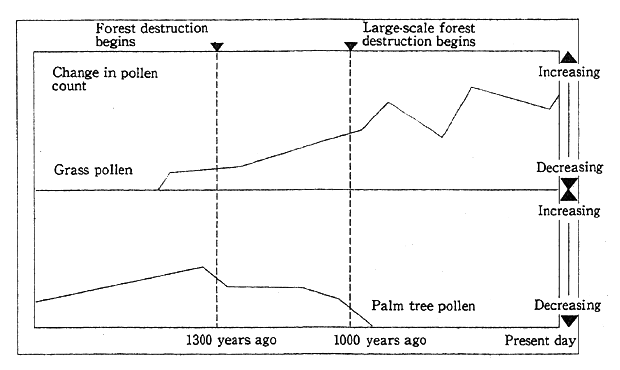
Displays changes in pollen counts found in-sediment in the volcanic Lake Lanokao. At one time, Easter Island had widespread forests of palm trees, etc. But from about 1300 years ago, pollen from palm trees and other kinds of trees began decreasing, while grass pollens were increasing. This suggests the beginning of the destruction of the forests. The forest destruction became large-scale about 1000 years ago, and tree pollens vanish, with grass pollens accounting for the vast majority discovered. (Source: from J. R. Flenly, 1991)
Reference: Yoshinori Yasuda, "A civilization that Disappeared Along with the Extinction of the Forests," "Newton", November 1994)
In 1722, when the Dutch Admiral Roggenveen was the first European to visit Easter Island, he saw people living in primitive conditions in grass-thatched huts and in caves. And in 1774, when the Englishman James Cook surveyed the island, he found that most of the stone statues had fallen over, and that the population was at around 600-700 people. (Source: Ponting, A Green History of the World)
2. Lessons from the Ancient Civilizations
As can be seen, civilization and the environment are deeply related to each other.
One is that civilizations relied upon and subsisted under such environmental conditions as climate, rainfall, irrigation conditions, soil, and forests. Egyptian civilization relied upon the blessings of the Nile River water and the fertile silt, while Mesopotamian civilization was blessed with the waters of the Tigris River and the Euphrates River, and the aspect cannot be denied that the dry climate that forced them into using those rivers prescribed their mode of civilization and also their rise and fall.
On the other hand, there are specific examples of ancient civilizations that have used the blessings of their environment, and have also had an effect on the environment. And that effect has sometimes damaged the environment beyond a certain limit, which in turn became a factor in causing the loss of that civilization's foundation and sending the civilization into decline. In such civilizations as the Egyptian civilization, which was under extremely blessed natural conditions whereby the soil was refreshed annually by Nile River floods, it would appear that the extent of utilization of the environment for building civilization was of a moderate scale. It stayed within the acceptable bounds of natural receptiveness for the Nile River, so that any direct effects that civilization might have on the environment was not tied to a decline in their own civilization. Moreover, a group whose relationship to nature was similar to that of the Egyptian civilization was Japan's Jomon culture. Jomon culture is said to have arisen on the basis of a seasonal cycle system between humans and nature whose core was rich forest resources. This seasonal cycling system whose core was forest resources is said to have been able to maintain coexistence with the environment. A number of civilizations, however, had huge effects on their environments, and damaged the environment that was the foundation of their subsistence, leading to decline and extinction. Examples can be seen in such civilizations as the Sumerian, who, because of the rising populations that accompany the growth of civilization, were forced to continue production without being able to assure sustainability of their irrigation agriculture. As result, they caused a catastrophic decline in foodstuff production with saline accumulations in the soil, and thus saw their civilization decline. The Easter Islanders, another example, continued to use their forests in an unsustainable way to assure wood for use as materials or fuel, or to assure farmland, and so caused their forests to decline and their soil to wash away, and which became one factor in the decline of their civilization.
Civilizations that went extinct always left a legacy which may perhaps have been carried on in some other civilization. Nevertheless, those civilizations that flourished in their own land were themselves unable to continue and were completely destroyed.
As can be seen from the above, humans have used the natural environment since recorded history began, or have extracted resources from the natural environment, and have formed civilized societies by placing burdens on the natural environment. These societies used agriculture for food production, formed cities that changed the natural environment, and produced and consumed many different items. And we could probably say that this was a world peculiar to humans that was totally different from pre-civilization, or from the natural world that was not affected by civilization. Nevertheless, in the same way that humans are unmistakably members of the ecological system as a life form, this civilized society is also a part of an ecological system, and cannot exist without a relationship to it. Human civilized society, or civilized human activities, has arisen by being based on the natural environment, by obtaining blessings from the environment, and by discharging unwanted items into the environment.
Modern civilization possesses some common factors in the abovementioned areas with the ancient civilizations. Yet, we also possess scientific technologies that the ancient civilizations did not have, and are in the process of accelerating the speed of expansion of our activities. Let's think about this in the next section on modern civilization and the environment.
Section3. Modern Civilization and Global Environmental Problems
1. Global Limitations on Modern Civilization
(1) Early-modern Western European civilization as the soarce of modern civilization
A special characteristic of modern civilization is the spread of mass production, mass consumption, and mass disposal social activities and lifestyles-in addition to the burdens placed on the environment by regular activities that have come to have important meaning because of environmental problems. Socioeconomic activities have, through trade and international investment, and through expansion of the scale of economies everywhere all over the world, expanded to a scale that can affect the entire global environment. Moreover, it appears that people will continue to seek to expand the scale of these activities. Although a technological revolution is promoting countermeasures one after another in response to the environmental problems that have appeared as this expansion of activities has progressed, problems are either unfolding at an even faster pace or completely unexpected new problems are arising. So, while remarkable results are being seen in one field, other problems remain where reform has been slow, and we have reached a condition today where we are faced with a variety of difficult environmental problems that reach all the way to a global scale.
In Japan, we have promoted energy-saving and resource-saving measures that, while achieving large economic growth, have also achieved such great successes as a reduction over a period of about 20 years of over 80 percent of sulfur oxides emissions that had been a big problem at industrial plants (OECD Environmental Performance Reviews: Japan). On the other hand, for example, are the nitrogen oxides in metropolitan districts, where the main source of emissions is automobiles. Despite great reductions in exhaust gas emissions per automobile when compared with emission volumes before regulations were implemented, increasing automobile traffic volume has made improvements very slow indeed (Figures 5-1-1 and 5-1-3). Moreover, energy demands in Japan continue to increase without pause, and emission volumes of carbon dioxide generated by the consumption of every kind of fossil fuel has also increased virtually without pause to the present time (Figure 1-3-1). CO2 densities on a global scale are also trending upward virtually without pause (Figure 5-1-9). Freon, as well, convenient for use as coolants, cleansers, foaming agents, and in sprays, because of its non-toxicity and difficulty in breaking down, was unexpectedly discovered to be causing a serious problem known as ozone layer depletion. In water quality, as well, where regulations concerning waste water from plants and factories have shown reasonable results, the pollution burden from domestic waste water has come to hold a fairly high percentage of the total. Moreover, pollution of the ocean by both land and seaborne sources has become an international issue. Discarded wastes, too, are increasing both in terms of total output volume and in output per person (Figure 5-4-1), while the increase in toxic wastes resulted in the problem of shipments of hazardous wastes across international borders, which eventually resulted in regulation by international treaty (Basel Convention on the Control of Transboundary Movements of Hazardous Wastes and Their Disposal). Populations, too, are rising rapidly on a global scale, centered in the developing nations, and this, too, is a factor in the rising burden on the environment (Figure 1-3-2).
Fig. 1-3-1 Trends in Japan's Carbon Dioxide Emission Volume
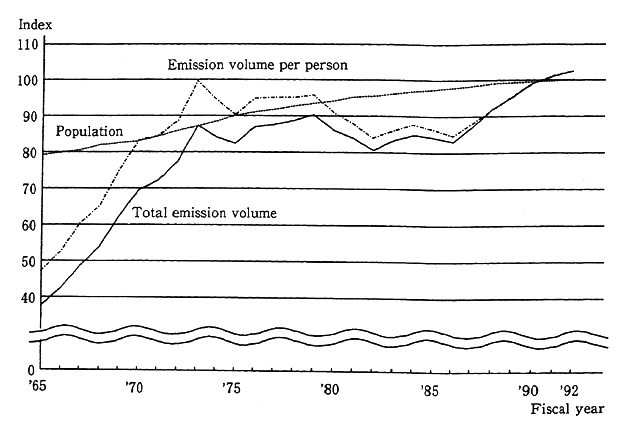
Note FY 1990 is a base year with index number 100.Data according to the Environment Agency.
Since the rise of civilization, humans have, when compared with other life forms, engaged in vast amounts of production, consumption, and waste, and the volumes have continued to rise. In recent years, however, the pace of expansion has picked up remarkably, and we have reached the point where limits on a global scale, both in terms of the environment and of resources, are beginning to come into view.
The source of modern civilization is the early-modern civilization that arose in Western Europe. And since modern civilization, which constitutes the spread around the world of that civilization in a form altered in America, is derived from the early-modern civilization that arose in Western Europe, it can be said that "the world today is completely under early-modern civilization."
Let us, therefore, take a simple look back at the developments that led the Western European civilization to become the modern civilization. (Reference: Takeo Yuasa, The Environment and Civilization ; others)
Western Europe's climate was different from that of the Mediterranean world or the West Asian world, being damp and cool. As a result, it can be said that the opponent that Western European civilization fought against was not water but forests. As Western Europe's luxuriant forests were cleared for a new farming method, agricultural production expanded and the population increased. The increase in population promoted further clearing of the forests. This resulted in a steady increase in population, but eventually limits were reached in clearing new farmlands or in improved productivity. Moreover, in the 14th century the climate turned colder, and failed crop years gave rise to starvation, and many people are said to have starved to death. In addition, the worsening social conditions led to severe clashes of interests, and wars erupted all over. On top of that, the Bubonic Plague arrived, and greatly reduced the population, leading to economic decline. In the five years from 1347 when the Plague was raging, one-third to one-half of the population of Europe is said to have died. From the 15th century onward, however, the decline in population in Western European civilization resulted in a higher cultivated area per person, making it possible to have stock-farming occupy a higher share of agriculture, which became one factor in the new growth. Productivity rose, while the labor shortage caused by the drop in population allowed the farmers to hold an advantageous position versus their feudal lords. As a result, economic activities by the farmers and others grew progressively more active, and demand for wood. rose still higher. The search on the peripheries resulted in further growth that expanded the extent of the civilized regions. So the destruction that Western European civilization experienced in the 14th century led to a revival and growth in the 16th century toward a Western European early-modern civilization.
Fig. 1-3-2 Population by Major Regions: 1950-2025
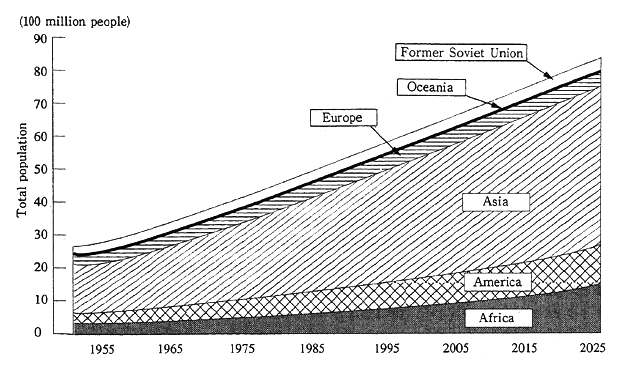
UN, World Population Prospects:1992
Reference: Ministry of Health and Welfare, Demographic Statistics 1994
In the 16th century and onward, Western European civilization, again faced with limits caused by food shortfalls and declining forest resources, spread its region of activities still further, to encompass within its region of activities, the American continent, the Australian continent, and the rest of the world. This developed into the Western European early-modern civilization. This civilization possessed the character of seeking value in markets that revolved around money, and continued to expand its production volume of goods (or in other words, consumption and waste volume). Maintenance and development of this civilization required vast amounts of natural resources as sources of energy and materials, and that activity also resulted in the output of much pollutants and unneeded items.
This utilization of natural resources stimulated steady expansion of the economy and population. Geographical expansion of the region of activity as a way to resolve problems caused by bumping up against the limitations on resources could be said to be what defines the Western European early-modern civilization, which had as its source Western European civilization. Modern civilization has built on that Western European early-modern civilization to expand the region of activity until it covers virtually all areas on the globe. Countries all around the world are engaged in trade, finance, investment, economic cooperation, and many other link-ups to varying degrees, to develop socioeconomic activities.
(2) Global limitations on modern civilization
In the previous section, we saw that ancient civilization through its own activities damaged the environment that was the foundations of its subsistence, sometimes leading to the extinction of that civilization, and another new civilization would be able to take up the inheritance of that destroyed civilization, with civilization flourishing in a new land with a favorable environment.
Moreover, when the forerunner to modem civilization, the Western European early-modern civilization, was faced with resource and environmental limits in its home region of Western Europe, it was able to overcome that by opening up Africa, Asia, North and South America, and other places all over the world, and using their resources, so expanded and developed its civilization.
Now, the scale of activities for modern civilization covers virtually every part of the globe, as it searches for resources in every locale, and extending its effects on the environment to the entire planet.
So today, modern civilization is directly faced with resource and environmental problems. One lesson that we have obtained from the histories of the ancient civilizations looked at heretofore is that if civilization damages the environment that is the foundation for its subsistence, that can become one factor in the endangerment of the civilization itself. On the other hand, while the Western European early-modern civilization was able to overcome the resource and environmental limits by searching for resources and environments in new lands, modern civilization has already expanded over the entire world, and can no longer use the previous methods to overcome the limits of the earth itself. While ancient civilization did not have the capability to affect the total global climate, modern civilization has been forced to face the fear of affecting the environment on a global scale in ways that cannot be redeemed. And while still facing international disparities between rich and poor, such as the so-called North-South problem, other serious problems, such as a rapidly growing population on a worldwide scale, are challenging the continued existence of civilization.
When we consider these lessons from history and conditions today, what philosophy will be necessary to ensure that we and our descendants can continue to live?
2. Advance of the Philosophy of Sustainable Development
The continued survival of humans requires that sustained activities continue under the premise that the earth's resources and environment are limited. On this point, let's consider whether it is possible to overcome these limitations by maintaining the expansionary tone of modern civilization.
(1) Limits on the expanding use of energy resources, etc.,and on geographical expansion
Modern civilization's expansion of activities has not been due to geographic expansion alone; the areas made possible by the technological revolution are also numerous. The technological revolution has not only pushed forward economic growth based on the consumption of many different resources, it has also made large contributions to the more efficient use of resources, saving of energy, and prevention of environmental pollution. The technological revolution will be, in the future, extremely important in facilitating more efficient utilization of limited resources and in controlling environmental destruction.
Nevertheless, whether we can rely on the technological revolution to resolve all environmental problems that we are presently faced with, without attempting to change the expansionary tone of modern civilization, is a separate issue. Once, when the Western European civilization found itself facing the wall of exhausted forest resources, it was able to break through the wall by acquiring the technology to use fossil fuels, which could be used in much greater volume than the fuel supplied from forests. But the high-volume utilization of fossil fuels, which is proceeding at a pace magnitudes faster than the pace at which forests accumulate solar energy, has caused a new problem concern about hard-to-resolve global warming developing alongside the emission of carbon dioxide. Moreover, exhaustion of the resources themselves is also become a real problem.
As we reconsider the socioeconomic activities and lifestyles that have brought us to this current state of mass production, mass consumption, and mass disposal, the role of the technological revolution will also itself have to change. In other words, as long as the basic issue of the future society and economy involves changing the patterns of production and consumption to something that is sustainable, we shall also have to reconsider the significance and validity of the technological revolution, and it will become increasingly important in the future to develop and promote appropriate technologies for that direction.
Now, is it not possible to overcome the limits of the global environment by extending the geographical expansion to beyond the earth itself? Could we not, for example, construct artificial habitable spaces for humans on Mars, and then move large numbers of humans over there? From the standpoint of resolving the global environmental problems currently facing us, the chances appear to be slim of us being able to carry this out, both in terms of time and of cost. In this sense, the knowledge and technology obtained from space development will for the time being be important only in terms of how it can contribute to the maintenance of the global environment.
As we continue this line of thinking, then it appear that we must confront head-on the limitations of the global environment, and should consider how to shift over to a society that can maintain sustainability.
(2) The course of international society toward sustainable development
Clearly-formed discussions first took shape in the 1970s about the possibility that our society and civilization is beginning to be faced with limitations on a global scale, and that resolution of this will necessitate conducting activities that are sustainable within the bounds of limited resources and environment.
Moreover, that necessity eventually won international agreement, with the key word being "sustainable development."
The problem, however, is obtaining specific agreements on this philosophy, and then implementing them. We must do these things to maintain for the future the limited global environment that is humanity's common foundation for the survival of our civilization, and to be able to pass the blessings of the environment on to future generations.
If we look back on the main points concerning the progress of international agreements about reconsidering the ways of modern civilization, and about the philosophy of "sustainable development" that has become the key word for protecting the environment-that is the foundation for our survival-it begins with the 1972 announcement by the Club of Rome on the "Limits to Growth." This report forecast that "If the present growth trends in world population, industrialization, pollution, food production, and resource depletion continue unchanged, the limits to growth on this planet will be reached sometime within the next one hundred years." They also predicted, however, that "It is possible to alter these growth trends and to establish a condition of ecological and economic stability that is sustainable far into the future."
In 1984, a United Nations resolution, based on a proposal by Japan, established the World Commission on Environment and Development, which in 1987 issued a report called "Our Common Future," titled in Japan as "Protecting the Future of the Earth." The term of "sustainable development" was proposed in this report.
According to this report, sustainable development means "development that meets the needs of the present without compromising the ability of future generations to meet their own needs" and that "sustainable development requires the promotion of values that encourage consumption standards that are within the bounds of the ecologically possible and to which all can reasonably aspire."
The concept of sustainable development was again taken up in 1992 at the United Nations Conference on Environment and Development (UNCED/Earth Summit), where representatives from about 180 nations, including the heads of state of more than 100 countries, gathered to pass Agenda 21, an action plan aimed at achieving sustainable development, and the Rio Declaration on Environment and Development.
At the present time, international society should be in the process of seriously implementing the broad range of action themes incorporated into Agenda 21. A follow-up group, the Commission on Sustainable Development (CSD), meets annually at the United Nations, and actively plays a central role in following up on Agenda 21.
As can be seen, "sustainable development" has today won common worldwide recognition as a key word in dealing with environmental issues.
(3) Lessons from sustainable civilization and from traditional culture
Now, concerning the realization of sustainable development, of the civilizations or cultures that have existed to date, let's consider those civilizations and traditional cultures that have survived for relatively long periods without suffering a decline due to damage to the environment.
Egyptian civilization, for example, was able to obtain new fertile soil every year from the annual flooding of the Nile, and was able for a long time to continue cultivation within those bounds, and to continue the civilization that it was based on.
In last year's Annual Report, we focused on the socioeconomics of Japan's Edo Period. We saw that Edo, a huge metropolis with a population of a million people, more than ten times that of London at that time, was able to maintain a very high level of civilization and culture even as the country as a whole was closed to the outside world, because it was based on material recycling, and was able to maintain a coexistence between nature and humankind, and so was able to continue in a relatively stable fashion.
Moreover, it is said that, among the Ainu people, food obtained from the sea or the rivers was deemed to be a blessing from God. They also had a hunting custom of never taking the last animal but instead leaving some for other life forms, because they believed in the need to coexist with others such as the bears and foxes.
Many of the world's aborigines protect the natural ecology within the bounds or customs of their societies, and are organized to continue obtaining these blessings. They are said to have a beneficial sense of values, the traditional knowledge, and the technology for managing natural resources to promote appropriate and sustainable development in terms of the environment. There are many things that we, who have brought upon ourselves the dangers to the environment on a global scale and who must aim for a solution, can learn from the words of these aborigines in possession of these traditions and experiences.
Norway's Prime Minister Gro Harlem Brundtland, who served as chairperson of the World Commission on Environment and Development, said the following.
"Traditional cultures are repositories of vast accumulations of knowledge and experience that link humanity with its ancient origins. The disappearance of such cultures constitutes a loss for society at large, which has a great deal to learn from their traditional skills in managing very complex ecological systems in a sustainable way.... The marginalization of traditional cultures is a symptom of a cycle of development that tends to neglect both human and environmental considerations. That is why a more careful and sensitive consideration of their interests is a touchstone of a sustainable development policy."
Although it may be lengthy, let's look at some statements that aboriginal people have made about the environment. (Source; "Story Earth: Native Voices on the Environment", Inter Press Service Corp.)
Mr.Joseph Bruchac of North America's aboriginal Abenaki tribe said the following.
The idea of the circle, in one form or another, was a guiding principle. There was no clock time, but cyclical time. The seasons completed a circle, and so too did our human lives. If we gather berries or hunt game in one place this year, then we may return to that place the following year to do the same. We must take care of that place properly-burning off the dry brush and dead berry bushes so that the ashes will fertilize the ground and new canes will grow, while at the same time ensuring that there will still be a clearing there in the forest with new green growth for the deer to eat."
"The circle is the way to see. The circle is the way to live, always keeping in mind the seven generations to come, always asking: how will my deeds affect the lives of my children's children's children? This is the message I have heard again and again. I give that message to you.
Mr. Salvador Palomino of Peru's Quechua tribe said this.
"For us Quechua people, religion is really a way of life, a knowing, an understanding, living side by side with the forces of nature in holy mutual harmony. We Indians deify all nature's forces, not because we're afraid or because we see them as something supernatural, but because we have known and understood the truth of their laws. We treat them with respect and recognize the benefits of life that we receive from them. . . (omitted) . . . We indigenous people only want to live in communion with nature. Any violation of its laws and physical integrity is also an act of violence against our societies and our people themselves... (omitted)... It is we Indians who are today's guardians of this spirit, a spirit that shapes an entire system of life, in spite of the insurgence and domination of the Western system, which, to our eyes, is anti-nature and egoistic."
King Moshoeshoe II of the African kingdom of Lesotho (Basuto tribe of Lesotho) had this to say.
"In Africa, this culture fully understood what the environment was all about-a natural habitat in which the human being lives and interacts and on which it depends for survival. It was recognized that harmony between the human being and the environment is an essential requirement for any sustainable livelihood and development and that the overall balance and well-being of both the human being and the environment are vital."
What these statements have in common is a restrained mode of behavior, in that when humans use nature or when extracting resources from nature, they maintain the natural ecology without exhausting or damaging the limited resources, and use it in a sustained way in coexistence with it, that probably lies within the customs and bounds of society.
But some theories say that even these aborigines, with their philosophy of coexistence with nature, have a history of using nature in a non-sustained damaging way.
For example, P. Martin says that the ancestors of the Indians entered the new continent from about 12,000 years ago and in almost no time at all used javelins tipped with stone-edged tools to drive 33 species of large beasts on the continent into extinction, including the mammoth, mastodon, horse, and camel. According to this theory, the Indians learned from the results of this experience to choose a way of life that coexisted with nature.
The modern civilized society of today possesses highly developed scientific technologies and advanced productive capability, and mass production is a presumed given, creating a fundamentally different situation from that of aboriginal societies. Nevertheless, the modern civilized man, who holds the capability for highly developed scientific technologies and mass production, and therefore possesses a far wider range of activities than the aborigines, is in the same position as the aborigine in that the environment is limited; that even humans are just one member of the ecology and cannot live if that ecology is damaged; that development, therefore, must continue within the bounds of that limited environment; and that the environment be used in a sustained way. What is different for the modern civilization is the fact that the limited environment now covers the entire earth. This has made it difficult for aborigines to find still more outside environments, so that assuring sustainability is even more important for us today. In this sense, it is all the more important for us to take into consideration what we can learn from the words of the aborigines on how to assure the sustainability of modern civilization. And today, with limits on a global scale now coming into view, and modern civilization caught in a situation where problem resolution will not be easy, by learning from our own experiences and from the past experiences of other civilizations to build a society based on new concepts, it will certainly be possible for us to open up a bright new future.